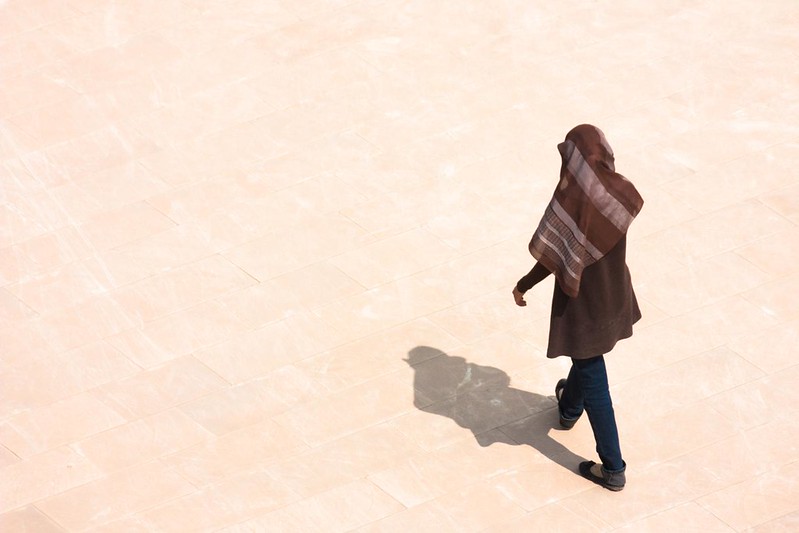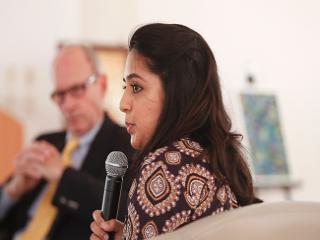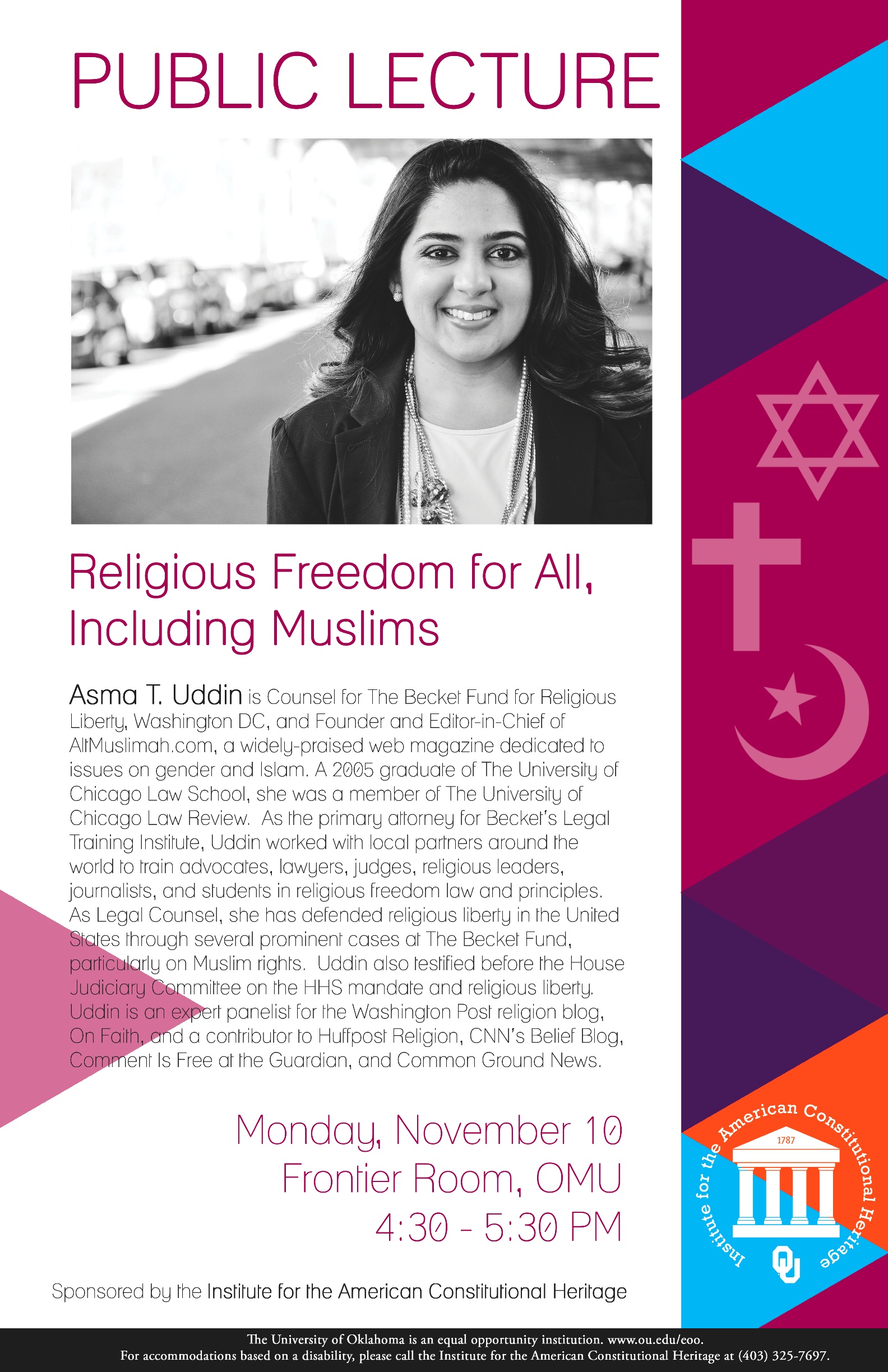Altmuslimah’s Sarah Jawaid discussed modesty and the burqa ban on NPR. Though the burqa and niqab have made news in recent months, Islam is only one of many religions that connect modesty to faith with specific garments. Many Mormons, Amish, Orthodox Jews and Christians promote modest appearance, among men and women, to various degrees.
NEAL CONAN, host:
This is TALK OF THE NATION. I’m Neal Conan, in Washington.
In recent weeks, skirmishes in the cultural conflict over the clothes worn by some Muslim women erupted in Belgium’s parliament, in an Italian court and at a traffic stop in France. The burqa and the niqab cover a woman’s body almost completely, but there are also disputes over less comprehensive coverings, including the head scarf.
While the issue of the moment is about Muslim dress, Islam is hardly the only religion that connects modesty to faith. Mormons wear special garments. Amish women adopt plain clothes and cover their heads – men, too. Some Jews and Christians either encourage or require modest appearance, and many faiths have rules about hair – again both male and female.
Is this tradition or scripture? What kinds of problems do these practices present in a largely secular world? If you practice modesty as a way to connect to your faith, we’d like to hear from you. Give us a call: 800-989-8255. Email us: talk@npr.org. You can also join the conversation on our website. That’s at npr.org. Click on TALK OF THE NATION.
We begin with Sally Quinn, founder and co-moderator of On Faith, a religion blog for the Washington Post. And she joins us from the studio at the newspaper. Nice to have you back on TALK OF THE NATION.
Ms. SALLY QUINN (Founder, Co-moderator, On Faith): Thank you for having me.
CONAN: And Islam is – obviously, as we mentioned – the issue of the day. But these kinds of regulations and rules cover any number of religions.
Ms. QUINN: Well, almost all of them, and in most of them, they’re gender-related. The issues are that women are obviously required to be more modest than men, and this is obviously causing a lot of problems, particularly today.
I mean, we mentioned France, which is really almost at sort of crisis proportions now with the banning of the burqa and even the banning of wearing head scarves, the hijabs, in the schools.
And it just seems to me that the whole idea of what’s going on in France has sort of turned the issue upside-down, where the French say that they are basically trying to save women from being second-class citizens by not allowing them to wear the burqa, because that somehow means that women are inferior, that women are forced to cover up to be modest.
And yet a lot of women, young Muslim women today, are saying not necessarily that they want to wear the burqa – there are very, very few women who wear that in France, maybe 1,500 or 2,000 – but head scarves are a sign of religious identity and a sign of liberation, that they can wear whatever they want to wear, so that you’ve got this incredible conflict going on between people who are saying we’re going to liberate these women from wearing what they supposedly are required to be wearing in their religion by doing something even worse, which is to say we’re not going to allow women to wear what it is that they want to wear.
CONAN: They want to wear. Yeah. Well, that’s an issue of the government’s role in this, but we’re trying to focus today on – is this scripture? Is this tradition? Is this – where does this come from?
Ms. QUINN: Well, you – for one thing, you can’t – every one of the religions is different and has a different way of looking at it. And some – it’s always cultural, always. You can’t escape that. And in some cases, it’s religious, as well.
If you look at the Jewish tradition, the idea is to humble yourself before God, and you put – the men wear yarmulkes. The women will cover their heads. It’s a lot about covering your hair, and the idea being that you would – that you’re showing humility, that God is the only one that we praise, and therefore we need to show in a way that we are human, and this is a sign of respect.
And I think for Islam, you know, the thing that’s interesting about Islam is that the head scarf, the head covering really began with Mohammad’s wives. He had a number of wives, and he didn’t want them to be pestered when they went out, because people would recognize them. So they covered their heads with scarves so that people wouldn’t recognize them and they could walk freely, you know, through the streets without having people point at them and know who they were.
So it was really – it was sort of the old-fashioned way of today movie stars wearing scarves and dark glasses…
(Soundbite of laughter)
Ms. QUINN: …to, you know, to sort of keep the paparazzi away. And then it sort of developed that that was a sign that Mohammad wanted women to cover their heads, and then, you know – but all of these religions have changed in different directions, and I think the idea, ultimately, is that women are always treated as second-class citizens in every religion. There’s no question about that.
CONAN: I remember my Roman Catholic upbringing, and that men could not cover their heads in church and that women must. I never figured that out.
Ms. QUINN: Right. No, I mean, I was actually talking to a woman minister, a friend of mine, today about it, And we were saying why, and she said: I don’t know why women cover their heads in Christian churches and Catholic churches and men do not, but for – and it’s – this is custom. This is cultural. This is about tradition. It’s disrespectful for a man to wear a hat in church, but it is disrespectful for a woman not to.
This is in the old days. I think now what people are wearing pretty much goes. But the idea of covering up is the idea that men are lustful, these crazed, wild, lustful animals who cannot possibly see a woman’s ankle without going insane, and therefore the women would cover themselves up as a favor to the guys.
You know, we’re going to give you a break, fellows, by covering ourselves up so that you don’t, you know, sort of writhe around in lust all day long, and you can actually get some work done, I think.
(Soundbite of laughter)
Ms. QUINN: I mean, that really is the case in a lot of ways, is that men couldn’t control themselves. Women could, sexually, and therefore women were protecting the men by covering themselves up so that the men would not be distracted.
And then it sort of, it ends up being that women were forced to cover themselves up so that – I mean, a lot of it has to do with power and subservience. And if men want to be in charge, then what’s the best way to do that, is to keep the woman down in some way.
And so if the woman covers herself up completely, that means, in a way, she’s owned by the man. No other man can look at her except for her husband – and even, you know, in the streets, but even sort of elder members of the family sometimes.
And there’s no other way to look at it, except that it’s subservience. And, you know, I am totally respectful of any woman who wants to cover herself up for religious reasons, because of her personal identity with her faith, whatever, as long as she is not forced to do so.
CONAN: Well, let’s bring one of those voices into the conversation. Sara Jawaid is with us, associate editor for altmuslimah.org, a website focused on gender in Islam. And she’s been kind enough to join us here in Studio 3A. Nice to have you on the program with us today.
Ms. SARA JAWAID (Associate Editor, altmuslimah.org): Thank you so much for having me.
CONAN: And you were a hijab, the head scarf. Is this a sign of subservience?
Ms. JAWAID: Definitely not, no. I actually started wearing hijab about two years ago. I’m in my early 20s. So this was a decision that I made while I was in grad school.
I realize that, you know, this is something that, you know, this is something that so many seem to have an opinion on. I had professors who were adamantly opposed to it. There was people who believed that this was mandatory in faith, and then there was those who didn’t.
There was people who had anecdotal mishaps with it. And there’s just so many voices in my head, and I just realized that all of that didn’t matter. At the end of the day, it was about how I wanted to connect with my creator, how I wanted to experience my faith. So it was my personal expression.
And it wasn’t easy. It isn’t easy. It’s been – yeah…
CONAN: Anecdotal mishaps.
Ms. JAWAID: Yeah, well, I mean, there’s – I mean, I’ve heard of stories where women will put on the hijab and then they somehow, you know, maybe think that they’re better than when they don’t, and then those women, like, have a bad taste in their mouth from it.
And I actually thought about that a lot before putting it on, that that was not going to be the way that I would practice my faith, that this would not be – I was not going to be judging people, that this was just – again, it was a very personal experience and happens to be an external manifestation of something personal.
CONAN: It is a statement, and statements can sometimes be misinterpreted.
Ms. JAWAID: Right, of course. Yeah.
CONAN: And you said it hasn’t been easy. Can you give us an example?
Ms. JAWAID: I think it’s been more the internal struggle with it. I mean, hijab for me has been an education in self-acceptance, in forgiveness and in understanding diversity of other women and people in general.
By self-acceptance, I mean that – I mean by trying to understand beauty of myself in a very different way. I’m choosing to not conflate body image with self-image, which is something that many women struggle with, and I’m choosing to experience my beauty in a way that, you know, that I don’t otherwise see in TV and in magazines. So, yeah.
CONAN: And would you accept that sometimes it is – not necessarily hijab, and certainly not in your case – but that it is a statement of subservience, or can be?
Ms. JAWAID: Yeah, it can be. I can understand that. It’s just that is so far from my internal dialogue. I mean, I was never forced in any way. I actually grew up in a household where this wasn’t really the norm.
My parents did encourage modesty, of course, but they didn’t ask me to wear hijab. They actually were concerned after I put it on just because we live in a post-9/11 world, and they were just worried that I would get a lot of – I was just making things difficult for myself, pretty much.
CONAN: Sally Quinn, we just have a minute or so before we have to go to a break, but do you ever remember, or can you inform us, has there ever been anything like this controversy that we’ve seen over the clothing that some Islamic women wear?
Ms. QUINN: No. And, you know, it’s interesting, because you see nuns walking down the street in habits, completely covered up, and nobody starts screaming and yelling and telling them they can’t wear habits. That would be completely out of the question.
And I don’t get it. I just don’t understand what the problem with the hijab is at all. You know, I remember the old Grace Kelly movies where she’s driving down the highway in the south of France with this fabulous scarf around her head and dark glasses. And you just think oh, my God, that is the most gorgeous – you know, and now the French, who are famous for making all these beautiful scarves that women wear on their heads, are trying to tell women they can’t wear scarves. It just – it makes no sense at all.
I mean, I can see the idea that it might be seen as coercion, but if it isn’t coercion, then I just don’t understand the problem.
CONAN: We’re talking about modesty and religion. If you practice modesty as a way to connect to your faith, give us call: 800-989-8255. Email us: talk@npr.org. In a few minutes, we’ll talk with Brenda Sharman with Pure Fashion, a faith-based program that promotes modest dress among young Christian women. So stay with us.
I’m Neal Conan. It’s the TALK OF THE NATION from NPR News.
(Soundbite of music)
CONAN: This is TALK OF THE NATION. I’m Neal Conan, in Washington.
We’re talking about religion and modesty. These days, we hear controversies about wearing or banning the burqa, but modest dress is in no way unique to the Muslim faith. Most beliefs include some instruction on how to dress appropriately.
If you practice modesty as a way to connect to your faith, tell us your story: 800-989-8255. Email: talk@npr.org. You can also join the conversation on our website. That’s at npr.org. Click on TALK OF THE NATION.
Our guests are Sally Quinn – founder and co-moderator of On Faith, a religion blog for the Washington Post – and Sara Jawaid, associate editor for altmuslimah.org, a website founded on gender in Islam.
And let’s see if we can get a caller in on the conversation. Let’s go to Erica, Erica with us from Park City in Utah.
ERICA (Caller): Hi. I’m a practicing Mormon, and I wear the temple garment, and I just want to talk a little bit about that, and I want to do it in a respectful way because it’s a really sacred thing for Mormons.
But it’s – modesty standards for Mormons are exactly the same for men and women, which is a wonderful thing. When you’re a young adult and you’re a committed Mormon, you make the decision to go to the temple. And in the temple, you make promises to God, and then you promise to wear this – for lack of a better word – underwear that goes, it’s like short-sleeve and then goes down a little bit above your knees.
And the reason I do it is I want to remember those promises to God, and men and women have exactly the same standard. It’s not anti-body in any way. Mormons don’t even believe in original sin. We think bodies are fantastic. We think sex is fantastic in the context of marriage.
And so it’s something that gives great comfort to me, and it’s also -and it keeps me modest. It keeps my shoulders covered. It keeps me from wearing short shorts. We believe that these bodies we have are incredible, joyful things made in the image of God, and we don’t want to desecrate them, and, you know, a tube top and a thong in public is not really the right thing to do. So…
CONAN: Does it make life easier that this is essentially invisible, as you suggest, an undergarment?
ERICA: Well, I’ll tell you, the older you get, the better it is in terms of modesty. It looks better and better.
(Soundbite of laughter)
Ms. QUINN: Sounds like Spanx to me.
(Soundbite of laughter)
ERICA: Kind of. But it – once you make that decision, it’s not so hard. And you really feel like you stand for something, which is wonderful -yet it works. I mean, I have a lot of sympathy for Islamic women, because it’s so hard to work in the 21st century. This works in the 21st century. We don’t wear them with bathing suits, for instance.
CONAN: I can understand that, yeah. Sara, I wondered if, Sara Jawaid, if you had some response to her.
Ms. JAWAID: I mean, I can understand that. I think it does work, and I feel like I can and have been negotiating my religious identity with my culture, both American and that of my parents from Pakistan.
So, I mean, again, as Sally was saying earlier, I don’t get it, either. I don’t know what the big deal is. I mean, I don’t know why religious garb is, like, pushed into the realm of legality when – and on the front page of the newspapers. I mean, these are personal choices, and that’s where they need to be left.
CONAN: Erica, thanks very much for the phone call. Appreciate it.
ERICA: Sure.
CONAN: Bye-bye.
Ms. QUINN: You know, I have many Mormon friends and many who wear the garments, and it’s just – it’s never an issue. It’s what they want to do, and as Erica said, the men and women both wear them.
But, you know, so much of this is cultural, too. We keep going back to culture because it’s hard in the case of modesty and dress to separate culture from religion. And, I mean, if you go to a beach on the south of France or anywhere in Europe, you’ll see the women in tiny, tiny little bikini bottoms and no tops. And I can’t tell you what it was like the first time I went to a beach there with my husband and my son, who was about 15 or 14 years old. Their eyes were on sticks.
(Soundbite of laughter)
Ms. QUINN: They couldn’t believe what was going on. And the French men didn’t even pay any attention. I mean, they did not turn into lust-crazed animals, attacking the other women on the beach. They could have cared less. I mean, they were so nonchalant about it because it was so accepted and so part of the culture.
And yet, you know, on an American beach, if you saw somebody walking down with no top, people would be really shocked.
CONAN: Here’s an email from Scott: My family practices a tradition expression of Quakerism that is somewhat misleading referred to as conservative. As part of our faith expression, my family wears plain clothing, along the lines of traditional Friends, the Amish, Mennonites and other peace churches.
Tradition and scripture plays a role in our community’s decision to return to plain dress, but as your guest just remarked, it is mostly a nod to the necessity of humility before God and to present ourselves before others as servants of God. Our plain-dressed community is entirely voluntary, and there is no prescribed clothing amongst Quakers at the present that I am aware of.
So Sara Jawaid, don’t we really get into a controversy when people are forced to either wear or not wear something that, you know, that they’d like to do?
Ms. JAWAID: Yeah, absolutely. And that’s – I mean, that’s the problem. Again, like I was saying, it comes down to personal choice, and that’s where it needs to be left. They’re – yeah.
CONAN: Sara Jawaid, thanks very much for your time today. We appreciate it.
Ms. JAWAID: Thank you.
CONAN: Sara Jawaid is associate editor at altmuslimah.org – I hope I didn’t – could you correct me on the pronunciation?
Ms. JAWAID: It’s altmuslimah.com.
CONAN: Okay, .com, not .org.
Ms. JAWAID: It’s actually .com, yeah. Yeah.
CONAN: I apologize for that. Okay, well, we’ll get a correct link-up to that on our website at npr.org.
Ms. JAWAID: Okay, great, thank you.
CONAN: Just click on TALK OF THE NATION. And I apologize for that. Thank you very much, though, for joining us today here in Studio 3A.
Ms. JAWAID: Thank you.
CONAN: Let’s get another caller on the line. This is Tabitha, Tabitha with us from Clarksville in Tennessee. Tabitha?
TABITHA (Caller): Hi.
CONAN: Hi, you’re on the air. Go ahead, please.
TABITHA: Yes, I am a Christian. I practice Apostolic Pentecostal faith, and I only wear skirts or dresses that do not come above my knee, and my sleeves, I don’t wear, like, tank tops or, like, you know, sleeveless shirts, and I don’t cut my hair.
CONAN: And you don’t cut your hair.
TABITHA: No.
CONAN: And is this common in your community?
TABITHA: It is common among Apostolic Pentecostals, and there is a biblical basis for it. In Corinthians, it talks about the women, you know, cannot shorn her hair, which is if you translate over to modern terminology, it means to cut it.
And also, there’s also a scripture, something that I heard you guys talking about, about when the Roman Catholic churches and other Christian churches, it was unacceptable for men to wear head garments but acceptable for women. And that also comes from the Bible, where it talks about that it is a shame for a woman to pray with her head uncovered and a man to pray with her head – with his head covered.
CONAN: Mm-hmm. Is there any element – and thank you for that clarification – is there any element of judgment in this of people who don’t do what you do?
TABITHA: Actually, there really is. One of my professors at college -well, I’d say harass, but she kind of does it jokingly because she just likes to pick on me on one thing, but on another, she’s kind of serious about it. And she’s told me on numerous occasions that I’m being oppressed or that, you know, I’m being – you know, I shouldn’t be forced to do things.
And for me, it was never something that was forced upon me. I was 18 years old when I started, you know, wearing dresses all the time, and I had a lot of family members who didn’t understand it and to this day still don’t, 10 years later. So…
CONAN: Oh, so not everybody in your family does this?
TABITHA: No.
CONAN: But they’re okay with you doing it?
TABITHA: Yes. I mean, they are now. They’ve accepted it. But, you know, several years ago, they just, they really had a hard time with it, and, you know, and people see you as being – and I really understand what some of the Muslim women go through, because people feel like you’re being oppressed, and, really, a lot of times, you have that choice.
And for me, it’s a personal relationship with God. It’s, you know, a decision that I came to, that I really prayed about and that I just really – is part of an expression of my faith.
The Bible, in Peter, talks about that, you know, we’re a chosen generation of royal priests and a peculiar people. We’re supposed to be different from the rest of the world, as Christians and as people who are serving God.
CONAN: Here’s an email that we have from a woman named Phoenix(ph) in Mountain View, California: My grandparents were Nazarene, a stricter Protestant religion. My grandmother always kept her hair up in a bun out in public, and though it wasn’t required by her religion, she told me saved something special just for her husband, to see her beautiful, long, red hair.
It was a form of respect, like a little gift for him, to know no man could see those beautiful locks except for him. After he passed away, she cut all her hair off as a sign of respect for him, as well.
And it just made me wonder, Tabitha, if you don’t cut your hair, do you keep it up in a bun?
TABITHA: Not always. Actually, I like to wear it down, but I do wear it up a lot out of convenience.
CONAN: Okay.
Ms. QUINN: You know what I think is so interesting and valuable about conversations like this is that it lets other people know exactly what people are doing and why they’re doing it. And I think if you listen to any of the people who have spoken on this show and called in and talked about what they wear and why they wear it and why they believe it, it doesn’t sound crazy. You know, it sounds like everyone who has spoken has been talking about his or her own respect for herself and her beliefs and the way that she wants to demonstrate her faith.
And I just think that it’s so important for people to understand everyone’s faith and everyone’s – and to respect other people’s faith, as long as people are not forced into wearing certain kinds of clothes or not wearing certain kinds. And, you know, you look at, for instance, nudists. A lot of nudist colonies believe that God created our bodies, that God created us in his own image and our bodies are beautiful and therefore are meant to be shown.
CONAN: He also created winter.
(Soundbite of laughter)
Ms. QUINN: Yes. And palm trees and…
(Soundbite of laughter)
Ms. QUINN: But so – how do you argue with that, either? I mean, if you want to say, look, I want to show my body, now there are places where you have to go and special places – you can’t just walk down the street because you would be accused of indecent exposure. But isn’t it interesting that if you walk down the street, if a French woman walked down the street in a bikini bottom and no top, she would not be accused of indecent exposure. But if she was on – she had happened to be on the beach – sorry, she would be. But if she were on the beach, it wont be a problem. So, I mean, a lot of this is – it’s social. It’s cultural. It’s habitual, and not a lot about religion. But in the cases of people who choose to dress certain ways, to be modest or not, it is an expression of their faith.
CONAN: Tabitha, thanks very much for your call. We appreciate it.
TABITHA: Yes. Yeah.
CONAN: Joining us now is Brenda Sharman, national spokesperson for Pure Fashion, a faith-based program that promotes modest dress among young women. And she’s with us on phone from her home in Georgia. Nice to have you in the program with us today.
Ms. BRENDA SHARMAN: (National Spokesperson, Pure Fashion). Thank you it’s my pleasure.
CONAN: And tell us a little bit more about Pure Fashion.
Ms. SHARMAN: Pure Fashion is a program for teen girls ages 14 to 18 that encourages them to live virtuous lives, including the virtue of modesty, which we feel like is often forgotten nowadays.
But the program was developed in 2005, and it was basically the answer to a common question amongst many mothers who were saying: Isn’t there something better that we could show our daughters than what we’re seeing at the malls? And can’t we show them that they can dress trendy and -that’s still tasteful, that they can be pretty without looking provocative? And the program was developed to help the high school girls to feel confident about who they are, and that then they present themselves in the way that doesn’t expose their body parts to get attention, and that they understand that what they wear does send a message, and that they want to be aware of that message.
And it’s not just actually what they wear, but it’s everything from how they speak, how they present themselves, their body language, what they’re saying, even the music they listen to and when they communicate with their friends. We just want to encourage purity of heart, mind and body.
Ms. QUINN: Do you also encourage young men the same age to do the same thing?
Ms. SHARMAN: Oh, absolutely, because the message is not just for teen girls. In the program, we work directly with the teen girls, but the message is actually for the whole family. And at the end of our program, we have a modesty fashion show. And families come all together and a lot of the dads enjoy the message just the same. Purity of heart is for all of us.
CONAN: We’re talking with Brendan Sharman of Pure Fashion – also with us, Sally Quinn, founder and co-moderator of On Faith, the religion blog for The Washington Post. You’re listening to TALK OF THE NATION from NPR News.
And I know, Brendan Sharman, you started this project, in part, because mothers are saying there’s nowhere to shop. There’s nowhere to find these clothes that are not provocative. And nevertheless, I’m sure you’re also familiar with the idea that telling a teenager to do almost anything will sometimes provoke the exact opposite reaction.
Ms. SHARMAN: Mm-hmm. Yeah. And unfortunately, the most immodest clothing at the mall is in the junior department. And girls want to shop where their friends shop. They want to go to those name-brand stores…
CONAN: Mm-hmm.
Ms. SHARMAN: …and they want to buy things there. But oftentimes, those are the skimpiest outfits. So girls can find clothing that is modest, they just might have to leave that teenager department, or they might have to go onto another store. And it is pretty easy to dress modestly. You just have to be a little bit more creative. You have to buy tank tops that you can wear under low-plunging necklines. You might not – you might walked by that rack of micro-mini skirts and short shorts, but next to it is typically a more moderate-length short, or you can get a skirt that’s a little bit longer. There a lot of options out there. So I don’t really believe it when girls say that they can’t find anything. They just might not be able to find anything in that junior department or in that junior store.
Ms. QUINN: A friend of mine today told me that she went shopping their daughter, who is seven, and they’re now selling thong underwear for seven-year-old girls.
Ms. SHERMAN: Actually, that’s a million-dollar business. The amount of sales in the thong department for young girls has sky rocketed in the last few years.
CONAN: And we’re getting more instruction, by the way, Sally, on the head covering in Catholic churches. Gerald in Grand Rapids emails: I’m more than little surprised by the Im not sure why. Go read Corinthians 11:13-16, part of the New Testament, which reads: Now I want to you realize that the head of every man is Christ, the head of every woman is man and the head of Christ is God. Every man who prays their prophecies with his head covered dishonors his head, and every woman who prays or prophesies with their head uncovered dishonors her head. And so that’s the scriptural source, there. So…
Ms. QUINN: Well, I’m glad to hear that. Isaiah says God is clothed in justice, humility and charity, being part of that. And that when one talks about what one wears, that you should keep in mind those three things as well: justice, humility and charity.
I think when you look at some of the women’s magazines today, that would be the farthest thing away from your mind. Now, I gather that Lady Gaga is preaching the new chastity, and that there’s a trend among sort of hip young women to talk about chastity and modesty and purity and all of that kind of thing. I don’t know whether they actually live up to it or not, but it does seem to be an interesting new trend.
CONAN: Brenda Sharman, we only have a few seconds left, but I wanted to ask you if your store is also – you get customers for a lot of religions too.
Ms. SHARMAN. Yes. Anybody can be a part of the Pure Fashion program. They would just have to understand going into it that a lot of the formation sessions that the young girls would attend, that it’s definitely a Christ-centered program, so the…
CONAN: Christian message would be delivered along with it.
Ms. SHARMAN: Mm-hmm.
CONAN: All right. Brenda Sharman, thanks very much for your time today. Appreciate it.
Ms. SHARMAN: Thank you.
CONAN: She’s national director of Pure Fashion, a faith-based program that promotes modest dress among young women, with us today from her home in Georgia. Sally Quinn, founder and co-moderator of On Faith, the religion blog from The Washington Post, joined us from a studio at the newspaper. Sally Quinn, thanks for your time today.
Ms. QUINN: Thank you.
CONAN: Up next: war as an insight into human nature, and what we lose by not studying military history. Victor Davis Hanson will join us. Stay with us. I’m Neal Conan. It’s the TALK OF THE NATION, from NPR news.



















